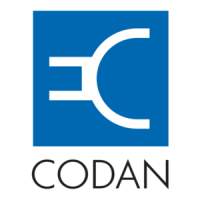8571—Technical description
NGT Transceiver System Technical Service Manual 343
Signalling and microprocessor
Microcontroller bus
The microprocessor IC12 on the Microprocessor & TCVR Interface PCB is an 80C552
and is a member of the Intel 80C51 8-bit microprocessor family. It has 256 bytes of
internal RAM, no internal program memory, two counter/timers, eight 8-bit ADC inputs,
a watchdog timer, I
2
C bus, and an internal clock oscillator.
The microprocessor operates in a conventional 8-bit data, 16-bit address configuration.
To minimise the pin count, the low-order address bits are multiplexed with the data on
pins 50 to 57 onto a common 8-bit bus. IC13 is used to latch the low-order address bits to
facilitate access to the external non-multiplexed devices. The ALE signal (IC12 pin 48)
indicates to the latch when the address is present on the bus. The high-order address bits
are provided directly on IC12 pins 39 to 46.
The following external devices are connected to the bus:
• IC14—an EPROM containing control firmware. The microcontroller selects the
EPROM via the PSEN signal (pin 47).
• IC15—a RAM device supplementing the microcontroller’s internal RAM. It is
selected via the Read or Write signals (IC12 pins 30 and 31).
• IC16—a triple-tone generator used to generate control tone and digital filter clocks
(see page 344, 300 Hz control tone—generation and detection).
A voltage detector and reset generator IC9 resets the microprocessor if the 5 V supply
falls below 4.7 V.
Connected to the input ports of IC12 (pins 1, 66, 67, and 68) is a binary switch
(designated as Mode Select).
Temperature sensing is monitored by the microprocessor at ADC input pin 62, by
measuring the voltage at the resistor/thermistor circuit R36 and R37. Battery-voltage
sensing is measured at the resistor-divider network R38 and R39 and is connected to
ADC input pin 64.
Internal I
2
C bus
Additional to the address and data bus lines, the microprocessor has an I
2
C bus that is
connected to the backplane and is used to operate the following:
• IC2—DAC located on the Dual Line Equaliser PCB enables the microprocessor to
select 64 DC steps between 0 to 9 V to control the threshold, gain, and equalisation
amplifiers.
• IC3—I/O 8-bit expander located on the Dual Line Equaliser PCB that has outputs to
control the transmit and receive audio paths.
The I
2
C bus is also used to communicate to the General Purpose Input/Output PCB.
Drawing 04-02690
Drawing 04-02541

